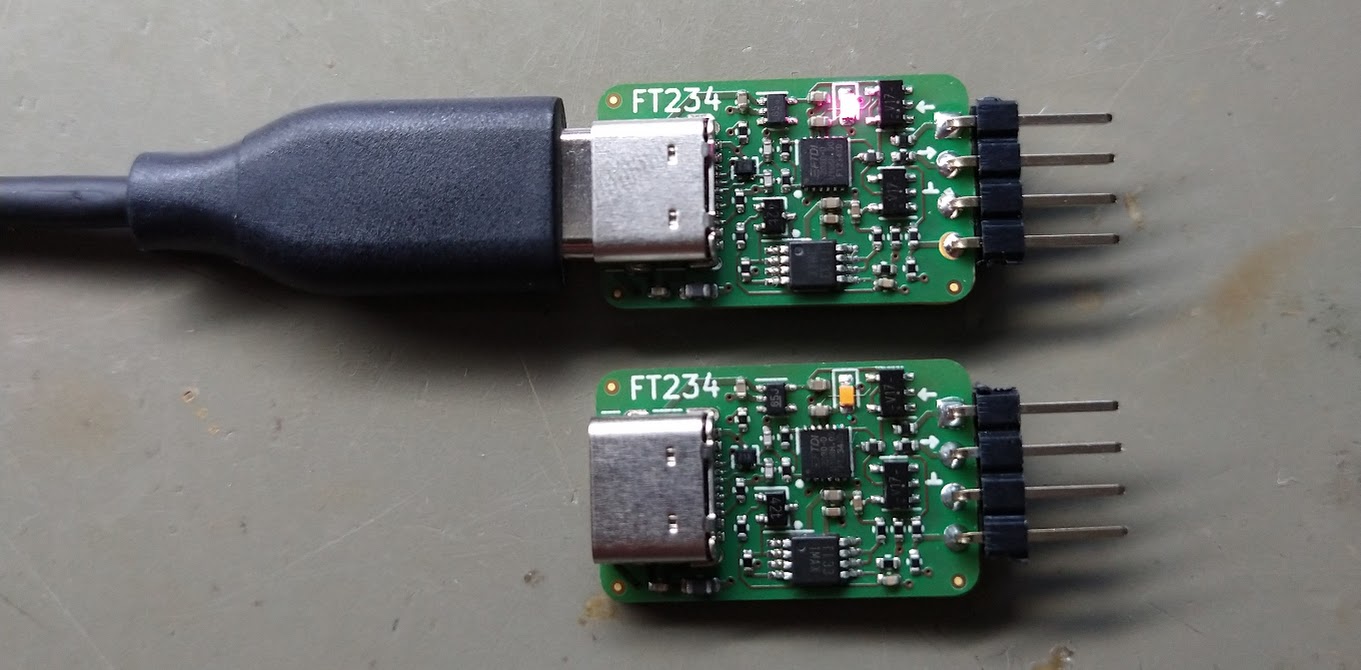FT234 autovtg

This USB to Serial Adapter was designed to be
- convenient & easy to use
- fool-proof
- fault-tolerant (i.e. prevent damage if connected incorrectly)
In most cases the target voltage is detected automatically without connecting the target voltage to a reference pin (see below).
For more exotic cases a dedicated Vtarget sense pin can be used nevertheless.
Specifications
| IC: | FTDI FT234XD |
| Signals: | GND, Rx, Tx, (Vtg - optional Vtarget reference voltage input) |
| IO Voltage: | 1.8V - 5V (automatic detection or via reference pin) |
| Baudrates: |
|
| Buffered IOs: | 74LVC1G17 Buffers These buffers prevent potentially damaging backflow current when only the target or the USB to Serial Adapter is powered. |
| IO Protection: | 120Ω series resistors on Rx/Tx. These resistors protect both the USB to Serial Adapter and the target by limiting the short-circuit current when the adapter is connected to the target incorrectly (e.g. adapter Tx connected to target Tx). Current limits:
|
| Connector: | USB-C |
| LED: | Rx/Tx (single LED for both) |
Buffered IOs
The most common USB to Serial Adapters have unbuffered IOs.
This means the in- and outputs of the converter IC are
directly connected to the target. When such an adapter is not connected to USB, but to a powered target, current flows
from the output of the target into the input of the converter IC and to Vdd through the
clamping diode.
The same problem occurs when the USB to Serial Adapter is connected to USB and an unpowered target. Current from the
converter output flows into the target input and to Vdd of the target through the input clamping diode.
This penomenon is called
back powering.
The backflow current often exceeds the maximum ratings of the ICs involved. This can permanently damage both the
(expensive) target and the USB to Serial Adapter. Modern 1.8V devices are more prone to permanent damage through
backflow current because their IOs are significantly less robust than old 5V IOs.
Suitable IO buffers (such as the 74LVC1G17)
prevent this by limiting the backflow current to a few µA.
With these buffers having an unpowered adapter connected to a powered board - and vice versa - no longer poses a risk.
Automatic Target Voltage Detection
Connecting a 3.3V USB to Serial Adapter to a 1.8V target (or a 5V adapter to a 3.3V target) can permanently damage
the target, because the excessive voltage can result in a high current through the clamping diode and an overvoltage
on the Vdd supply of the target.
Therefore buffered USB to Serial Adapters usually have a Vtarget (or Vtg) sense input for the target IO voltage.
The sense input is used to match the IO voltage of the adapter to the target.
This adapter also has such a Vtarget sense input, but in most cases connecting it is optional, because the adapter
can detect the target IO voltage automatically by deriving it from the target Tx signal.
This is done with a
peak detector circuit based on a common Operational Amplifier (a LMV358A). The automatic detection is designed to work with baud rates ranging from 4800 Baud up to 250kBaud.
For slower or higher baudrates (and for unidirectional use-cases where the target does not have a Tx signal)
a regular Vtarget sense pin is also available.